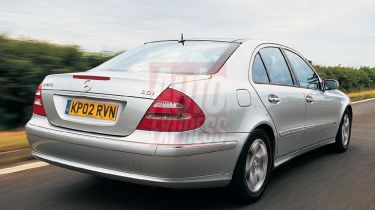Mercedes E270 CDI
For British executives, the gravy train has well and truly hit the buffers. No longer can you have the perk of a big luxury car without paying through the nose in taxation. But before you zip up that travel bag and head for the Cayman Islands, take a second to consider Mercedes' latest solution to your financial woes � the new E270 CDI.
Mercedes has pulled out all the stops to make the new E-Class the most technically advanced saloon available � not to mention one of the most desirable. It looks good, feels well put-together and is stylish enough to make your average executive go weak at the knees. But the 270 CDI's biggest selling point is its fast and frugal common-rail diesel unit. The car also beats most of its rivals for refinement, smoothing away the worst Britain's roads have to offer.
For British executives, the gravy train has well and truly hit the buffers. No longer can you have the perk of a big luxury car without paying through the nose in taxation. But before you zip up that travel bag and head for the Cayman Islands, take a second to consider Mercedes' latest solution to your financial woes � the new E270 CDI.
August sees the arrival of the next-generation E-Class range, and with it � for the first time in the UK � the introduction of a 2.7-litre diesel to plug the gap between the 220 CDI and 320 CDI, priced �27,435. But is it good enough to beat the all-conquering BMW 525d in the diesel executive sector and establish itself as the perfect company car?
On looks alone, the answer is a resounding yes. The overall feel of the car may be that of a traditional three-box saloon, but the newcomer's coup�-like roofline, subtle detailing and muscular rear end give it considerably more presence than the 5-Series. Unlike most current Mercedes models, the E-Class also carries on the long tradition of wearing its three-pointed star proudly on the bonnet. Even more importantly, it addresses an issue which has posed a real threat to the company's prestige image in recent years: build quality.
The cabin features tight panel gaps, high-grade plastics and finely weighted switchgear that exude a tactile, quality feel. And while the focus is more on luxury than sportiness, the interior is nevertheless a stylish and highly pleasant place to spend time � especially in the tasteful wood-and-chrome Avantgarde trim sported by our test car.
The E-Class's increased dimensions have boosted rear passenger space, and there are plenty of handy cubbyholes to keep executive types happy, including a cleverly designed rear armrest-cum-office-desk, a two-tiered lockable glovebox and a slide-out change-holder in the dashboard. And those with deep pockets can personalise their E-Class to a ludicrous extent: solar panels which power the ventilation system on hot days, seats that automatically grip you in bends, radar-assisted cruise control. Whatever next?
The real sweetener for company car drivers, though, is the blend of performance and economy offered by the recently revised 2.7-litre turbodiesel unit, previously seen in the M and S-Classes. Smooth, responsive and with remarkably little turbo lag, the common-rail oil-burner propels the 1,650kg car from 0-62mph in 9.0 seconds and on to a 142mph top speed. Exhaust emissions are also low � only 172g/km � and the official 43.5mpg combined fuel economy figure bodes well for running costs.
Refinement is right up there with the best of them, too. Although a little clattery at tickover, the engine smooths out to a distant, deep-chested thrum under full throttle and uses its hefty 177bhp and 400Nm of torque to make light work of overtaking. Our car's five-speed Tiptronic-style automatic box is ultra-smooth and worth every penny of its �1,450 price � although it doesn't adapt as readily to an aggressive driving style as the equivalent BMW unit.
The same could be said of the chassis. Over broken, bumpy surfaces the E-Class rides with supreme comfort, displaying admirable levels of damping ability and excellent high-speed composure. Barely a whisper invades the sanctity of the cabin at motorway pace, either, making it an ideal cruising tool.
But when it's pushed near the limit of its cornering ability, the car's composure begins to falter slightly as it struggles to contain rapid shifts of momentum. The 'brake-by-wire' Sensotronic Control also feels a little over-eager to bite, although there is no doubting its stopping power. Buyers looking for a sportier drive, however, can specify Airmatic Dual Control air-suspension for an additional �1,240.







